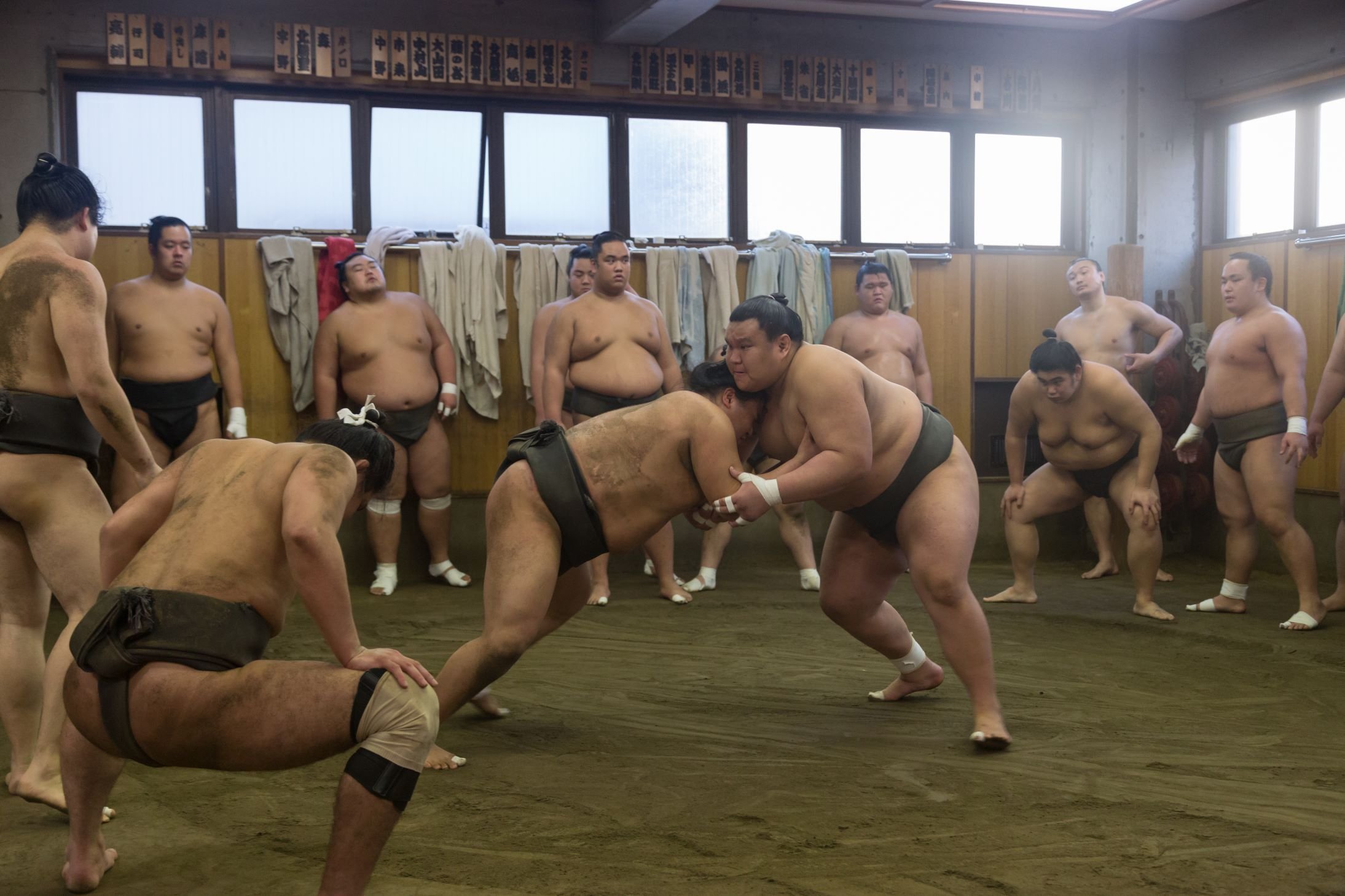12 Sumo Wrestling Facts You Must Know Before Catching a Tournament
The real deal: our sumo wrestling facts come as no surprise to these guys (Image Credit: Shutterstock)
More than meets the eye
To the uninitiated, sumo might seem almost comical, but in reality, it is steeped in seriousness and tradition. This article aims to uncover some of the sport’s curious and remarkable aspects, shedding light on why attending a sumo tournament is an experience not to be missed.
1. There is strong religious significance
Japan's esteemed national sport is deeply rooted in the country's spiritual and religious traditions, dating back about 1,500 years. Sumo's origins are intertwined with the ancient rituals of Shinto, Japan's indigenous religion. Originally performed at shrines, sumo was more than a sport; it was a sacred act to ensure a bountiful harvest and honor the spirits, known as kami.
Today, the religious essence of sumo is still prominently preserved. The ring-entering ceremonies are Shinto purification rituals in themselves. The ring itself, or dohyō, is a symbolic representation of a Shinto shrine.
The ritualistic throwing of salt by sumo wrestlers before a match is a purification practice, intended to cleanse the ring. The dramatic leg-stomping at the start of a bout, a familiar sight to sumo enthusiasts, has a purpose beyond intimidation; it is believed to drive out evil spirits. Even the referee's attire during a sumo bout is reminiscent of a Shinto priest's garb
2. Sumo is steeped in rules
Sumo wrestling is governed by a unique set of rules that add to the sport's intensity and excitement.
The commencement of a sumo match is a strategic game in itself. Both wrestlers must simultaneously place both hands on the ground before the bout begins. This rule often leads to a psychological battle, with wrestlers feigning the start by pretending to place their hands down, only to rise again in an attempt to psyche out their opponent.
The matches are known for their brevity and fast pace. Most bouts last only a few seconds, though on rare occasions, they can extend up to four minutes.
Victory is achieved if a wrestler manages to throw his opponent out of the ring or if any part of the opponent's body, other than the soles of their feet, touches the ground.
There are several ways a wrestler can be disqualified. One of the most unusual ways is losing one's mawashi, or loincloth.
3. The sumo life is about self-sacrifice
The lifestyle of a sumo wrestler, known in Japanese as a rikishi, is one of rigorous discipline and deep-rooted tradition. The heart of a sumo wrestler's life is the sumo beya or stable. This is not just a training facility; it's a home, a school, and a community. Wrestlers live, eat, train, and sleep in these stables throughout their career, until they get married and are permitted to live independently.
Sumo wrestlers are required to live a traditional Japanese lifestyle, which extends beyond the ring. This includes dressing in traditional Japanese clothing and adhering to a set of strict rules that govern their conduct, both in public and private.
At the helm of each stable is the stablemaster or oyakata, a retired sumo wrestler who was notable in his prime. Supporting the wrestlers and the stablemaster is a dedicated team that includes referees, ushers, and specialized hairdressers known as tokoyama. These roles are critical in maintaining the day-to-day operations of the stable and ensuring that traditions are upheld.
4. Do wrestlers have to be large?
In the past, sumo wrestlers were not typically the robust figures we see today. They were more wiry and muscular, embodying strength rather than sheer size. However, as the sport involves no weight divisions, a transformation occurred over the years, particularly in the 20th century.
Wrestlers began to increase their body mass significantly, aiming to use their weight advantageously in the ring. The lack of weight categories means that being larger can provide a significant advantage during competitions, as it prevents wrestlers from being mismatched against significantly heavier opponents.
Join a sumo morning training experience at one of the sumo stables at Ryogoku (Image Credit: Shutterstock)
5. Sumo wrestlers can’t drive
Here’s an odd one: active sumo wrestlers are not allowed to drive their own cars. This regulation, set by the Japan Sumo Association, is not a matter of law but rather an internal rule within the sumo community, stemming from both safety concerns and the preservation of public respect for the sport.
6. The referees are a bit deal
The gyoji, or sumo referees, hold a position of great significance. Their role is steeped in centuries of Japanese culture and tradition.
Gyoji begin their journey in the world of sumo at a young age, typically around sixteen, similar to the wrestlers. Their career is a lifelong commitment, continuing until they reach retirement.
At the pinnacle of their career, the highest-ranking gyoji is granted an honorific title, akin to the yokozuna rank for wrestlers. This esteemed position is known as Kimura Shonosuke, a title that can only be held by one individual at any given time.
7. There are strict rules around clothing
Sumo wrestling extends its cultural significance beyond the ring into the very clothing that sumo wrestlers wear. The attire of a sumo wrestler is an embodiment of the strict rules and hierarchical structure that govern their lives.
Upon joining a sumo stable, wrestlers are expected to grow their hair long to form a chonmage, a topknot hairstyle reminiscent of the samurai of the Edo Period. Wrestlers are required to dress traditionally when in public. The less experienced wrestlers, or lower-ranked rikishi, must wear a yukata, a simple cotton robe, paired with geta, traditional wooden sandals.
As sumo wrestlers rise in rank, they are afforded more liberties with their clothing. Higher-ranked wrestlers are allowed to wear more luxurious and higher-quality robes.
In the ring, sumo wrestlers don a mawashi, a heavy fabric loincloth, which is central to the sport. The mawashi is not merely a piece of clothing but a crucial part of sumo wrestling tactics. Wrestlers grip and hold onto their opponent's mawashi during a match, using it to gain leverage and advantage.
8. Sumos must act stoic and humble
Sumo wrestlers are bound by a stringent set of rules that dictate almost every aspect of their lives, influencing not just their training but also their public demeanor and personality.
The expectations for a sumo wrestler's behavior in public are strict and clear. Wrestlers are expected to be self-effacing and softly spoken, embodying humility and respect in their interactions.
During tournaments, wrestlers are expected to maintain a composed and stoic demeanor, regardless of the match's outcome. Exuberant celebrations, expressions of joy after winning, or overt disappointment after a loss are discouraged.
9. There are very particular hairstyles
The basic sumo hairstyle is the famous chonmage topknot, reminiscent of the styles worn by samurai in the Edo Period. But some high-ranking wrestlers will don the more elaborate ōichō, which the hair is fanned out more to resemble a gingko leaf. The Japan Sumo Association employs special hairdressers called tokoyama that specialize in doing sumo hair.
10. Not all sumo wrestlers are Japanese
Historically, sumo stables had the freedom to recruit multiple foreign wrestlers, leading to a more diverse range of athletes within the sport. However, a pivotal moment occurred when a stable recruited six Mongolian wrestlers simultaneously, sparking concerns and leading to a significant shift in policy. In response, the Japan Sumo Association imposed a restriction that now limits each stable to only one foreign wrestler at a time.
Foreign wrestlers entering the world of sumo are expected to learn and speak Japanese fluently and become well-versed in Japanese customs and traditions. Despite these challenges, many foreign wrestlers have risen to prominence in sumo, with several top contenders hailing from other countries.
11. Women are forbidden from being wrestlers
While many sports have both men's and women's divisions, sumo stands out for its strict gender exclusivity, forbidding women from competing professionally and even entering the sumo ring.
This prohibition is rooted in the belief that the presence of women would violate the purity of the ring, a concept intertwined with the sport's Shinto origins.
This gender-based exclusion became a topic of significant controversy during the tenure of Fusae Ohta, the female Governor of Osaka from 2000 to 2008. Traditionally, the Governor of Osaka presents the Governor’s Prize in the sumo ring at the end of tournaments. However, Ohta's role as Governor clashed with the Sumo Association's prohibition on women entering the ring. Despite her repeated challenges to the Association, requesting to fulfill her ceremonial role as Governor, she was consistently denied access to the ring, highlighting the rigid gender norms within the sport.
Interestingly, the exclusion of women from sumo was not always as strict as it is today. Historical records indicate that as early as the 18th century, a form of female sumo was common in some regions of Japan.
12. You can take the ring with you!
As a member of the crowd, don’t be afraid to cheer on the wrestlers! Despite how stoic they must act, audience members are allowed to be as animated as they like. When a match is over, be sure to grab a chunk of the clay ring as a souvenir.
Hakkiyoi!
Knowing your sumo wrestling facts makes a tournament more enjoyable to watch (Image credit: Shutterstock)
Understanding these facets of sumo provides a deeper appreciation for what happens in the ring. Now that you’re a sumo expert, don’t miss your chance to see a tournament on your next visit to Japan. We can even arrange for an entertaining sumo show run by sumo wrestlers, take a look at this video for more information! TokudAw will happily point you in the right direction and can even safely deliver you and pick you up with our elite private car service.



